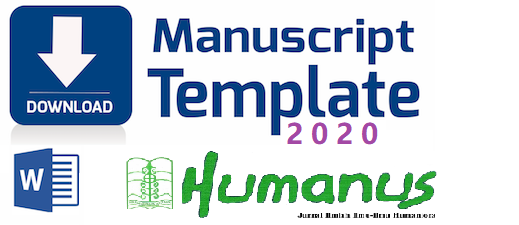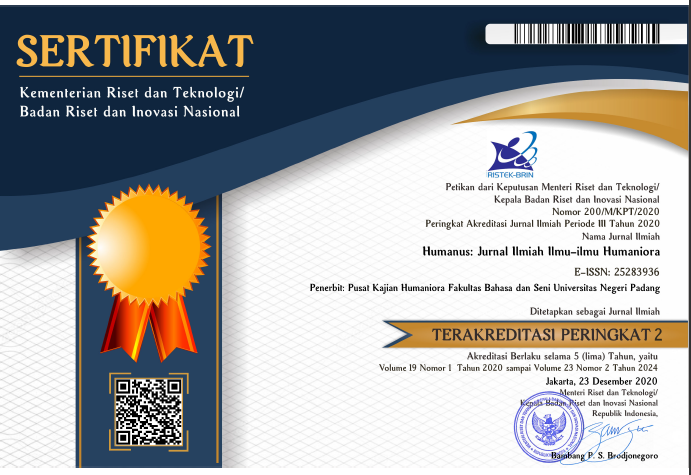Can Machine Translations Translate Humorous Texts?
 ), Muhd. Al Hafizh(2), Iftahur Rezqi(3), Raihana Tuzzikriah(4),
), Muhd. Al Hafizh(2), Iftahur Rezqi(3), Raihana Tuzzikriah(4), (1) (SCOPUS ID: 57202856216), (SINTA ID: 71918), (WoS ResearchID P-1090-2018), FBS Universitas Negeri Padang
(2) Universitas Negeri Padang
(3) FBS Universitas Negeri Padang
(4) Master of English Language Teaching FBS Universitas Negeri Padang
 Corresponding Author
Corresponding Author
Copyright (c) 2022 Humanus
DOI : https://doi.org/10.24036/humanus.v21i1.115698
Full Text:
 Language : en
Language : en
Abstract
Keywords
References
Afdhal, M., & Hamzah, H. (2019). An analysis of verbal humor found in Sitcom Tetangga Masa Gitu. E-Journal English Language and Literature, 8(3), 264–274.
Ardi, H. (2017). The Impact of Translation Techniques Toward the Quality of Translation: a Case Study on a Social Text. Humanus: Jurnal Ilmiah Ilmu-Ilmu Humaniora, 15(2), 142. https://doi.org/10.24036/jh.v15i2.6564
Ardi, H., Nababan, M. R., Djatmika, & Santosa, R. (2018). Characters’ politeness strategies in giving command: Should translators keep them? 3L: Language, Linguistics, Literature, 24(2), 181–193. https://doi.org/10.17576/3L-2018-2402-14
Bendi, M. (2019). Hybrid humour as cultural translation: The example of Beur humour. European Journal of Humour Research, 7(2), 87–99. https://doi.org/10.7592/EJHR2019.7.2.Bendi
Dahelza, D. L., Saun, S., & Ardi, H. (2013). Types and Meanings of Humors Used in T-Shirt Slogans in the Bad Idea T-Shirt Online. Journal of English Language and Literature, 1(1a), 34–45. Retrieved from http://ejournal.unp.ac.id/index.php/ell/article/view/1812
Delabastita, D., Gottlieb, H., & Davis. (2014). Essays on Punning and Translation. Retrieved from http://weekly.cnbnews.com/news/article.html?no=124000
Díaz-Pérez, F. J. (2015). The translation of wordplay from the perspective of relevance theory: Translating sexual puns in two Shakespearian tragedies into Galician and Spanish. Meta: Journal Des Traducteurs/Meta: Translators’ Journal, 58(2), 279–302. https://doi.org/10.7202/1024175ar
Dore, M. (2019). Multilingual humour in audiovisual translation. Modern Family dubbed in Italian. The European Journal of Humour Research, 7(1), 52–70. https://doi.org/10.7592/EJHR2019.7.1.DORE2
Ghasemi, H., & Hashemian, M. (2016). A Comparative Study of Google Translate Translations: An Error Analysis of English-to-Persian and Persian-to-English Translations. English Language Teaching, 9(3), 13. https://doi.org/10.5539/elt.v9n3p13
Groves, M., & Mundt, K. (2015). Friend or foe? Google Translate in language for academic purposes. English for Specific Purposes, 37, 112–121. https://doi.org/10.1016/J.ESP.2014.09.001
Hutchins, J. (2009). The history of machine translation in a nutshell. Retrieved from http://hutchinsweb.me.uk/Nutshell-2005.pdf
Keshavarz, M. H. (2012). Contrastive Analysis & Error Analysis (New Editio). Tehran: Rahnama Press.
Läubli, S., & Orrego-Carmona, D. (2017). When Google Translate is better than some human colleagues, those people are no longer colleagues. Proceedings of the 39th Conference Translation and the Computer, (November), 59–69. https://doi.org/10.5167/uzh-147260
Lee, S. M. (2021). An investigation of machine translation output quality and the influencing factors of source texts. ReCALL. https://doi.org/10.1017/S0958344021000124
Low, P. A. (2011). Translating jokes and puns. Perspectives: Studies in Translation Theory and Practice, 19(1), 59–70. https://doi.org/10.1080/0907676X.2010.493219
Martin, R. A. (2007). The psychology of humor: An integrative approach. Amsterdam: Elsevier Academic Press.
Martínez-Sierra, J. J. (2006). Translating audiovisual humor: A case study. Perspectives: Studies in Translation Theory and Practice, 13(4), 289–296. https://doi.org/10.1080/09076760608668999
Molina, L., & Albir, A. H. (2002). Translation techniques revisited: A dynamic and functionalist approach. Meta: Journal Des Traducteurs/Meta: Translators’ Journal, 47(4), 498–512. https://doi.org/10.7202/008033ar
Nababan, M. R., Nuraeni, A., & Sumardiono. (2012). Pengembangan model penilaian kualitas terjemahan. Kajian Linguistik Dan Sastra, 24(1), 39–57.
Napitupulu, S. (2017). Analyzing Indonesian-English abstracts translation in view of translation errrors by Google Translate. International Journal of English Language and Linguistics Research, 5(2), 15–23.
Nugroho, A. B. (2011). Teknik penerjemahan wordplay dan kualitas terjemahannya dalam novel Charlie and the Great Glass Elevator karya Roald Dahl. Universitas Sebelas Maret.
Oliveira, R. G. de, & Anastas, D. (2011). Comparison of SYSTRAN and Google Translate for English→Portuguese. Tradumàtica: Traducció i Tecnologies de La Informació i La Comunicació, 9, 118–136.
Omar, A., & Gomaa, Y. A. (2020). The machine translation of literature: Implications for translation pedagogy. International Journal of Emerging Technologies in Learning, 15(11), 228–235. https://doi.org/10.3991/IJET.V15I11.13275
Putri, G. D., & Ardi, H. (2015). Types of errors found in Google Translation: A model of MT evaluation. Proceedings of International Seminar on English Language Teaching (ISELT-3) 2015, 183–188. Padang: Sukabina Press.
Raphaelson-West, D. S. (1989). On the feasibility and strategies of translating humour. Meta: Journal Des Traducteurs, 34(1), 128–141. https://doi.org/10.7202/003913ar
Rescigno, A. A., Vanmassenhove, E., Monti, J., & Way, A. (2020). A Case Study of Natural Gender Phenomena in Translation A Comparison of Google Translate, Bing Microsoft Translator and DeepL for English to Italian , French and Spanish. CLiC-It.
Rezqi, I., & Ardi, H. (2022). An Analysis of Translation Acceptability in Translating Humour About Pun. Journal of English Language Teaching, 11(1), 77–86. https://doi.org/10.24036/jelt.v11i1.116310
Savage, B. M., Lujan, H. L., Thipparthi, R. R., & DiCarlo, S. E. (2017). Humor, laughter, learning, and health! A brief review. Advances in Physiology Education, 41(3), 341–347. https://doi.org/10.1152/ADVAN.00030.2017
Schmitz, J. R. (2002). Humor as a pedagogical tool in foreign language and translation courses. Humor: International of Humor Research, 15(1), 89–113. https://doi.org/10.1515/HUMR.2002.007/MACHINEREADABLECITATION/RIS
Sulaiman, M. Z., & Mohamad Yusoff, M. J. H. (2020). Bila dan Mengapa ‘You’ Menjadi ‘Kita’: Satu Analisis Perbandingan Inggeris-Melayu (When and Why ‘You’ Becomes ‘Kita’: A Contrastive English-Malay Analysis). GEMA Online® Journal of Language Studies, 20(4), 151–161. https://doi.org/10.17576/gema-2020-2004-09
Tuzzikriah, R., & Ardi, H. (2021). Students’ perception on the problem in translating humor text. Proceedings of the Eighth International Conference on English Language and Teaching (ICOELT-8 2020), 579, 326–331. https://doi.org/10.2991/assehr.k.210914.061
Wongranu, P. (2017). Errors in translation made by English major students: A study on types and causes. Kasetsart Journal of Social Sciences, 38(2), 117–122. https://doi.org/10.1016/J.KJSS.2016.11.003
Yahiaoui, R., Alqumboz, B., Fattah, A., & Al Adwan, A. (2019). Translating irony into Arabic – who’s having the last laugh? Dubbing Monsters Inc.: Egyptian vernacular vs. modern standard Arabic. The European Journal of Humour Research, 7(4), 32–46. https://doi.org/10.7592/EJHR2019.7.4.YAHIAOUI
Yamada, M. (2019). The impact of google neural machine translation on post-editing by student translators. Journal of Specialised Translation, (31), 87–106.
Yanisky-Ravid, S., & Martens, C. (2019). From the myth of Babel to Google Translate: Confronting malicious use of artificial intelligence - copyright and algorithmic biases in online translation systems. Seattle UL Rev., 43, 99–21.
Yuliasri, I. (2016). Translation techniques and pragmatic equivalence in Indonesian translation of humorous utterances in the Walt Disney’S Donald Duck comics. International Seminar Prasasti III: Current Research in Linguistics, 409–414. Surakarta: Universitas Sebelas Maret. Retrieved from https://jurnal.uns.ac.id/prosidingprasasti/article/viewFile/1554/1444
Yuliasri, I., & Allen, P. (2019). Humour loss in the Indonesian translation of Harry Potter and the Sorcerer’s Stone. Indonesian Journal of Applied Linguistics, 9(1), 119–127. https://doi.org/10.17509/IJAL.V9I1.14185
Zein, A. (2018). Peran Text Processing Dalam Aplikasi Penerjemah Multi Bahasa Menggunakan Ajax API Google. Sainstech: Jurnal Penelitian Dan Pengkajian Sains Dan Teknologi, 28(1), 1410–7104. https://doi.org/10.37277/stch.v28i1.270
 Article Metrics
Article Metrics
 Abstract Views : 841 times
Abstract Views : 841 times
 PDF Downloaded : 211 times
PDF Downloaded : 211 times
Refbacks
- There are currently no refbacks.
Copyright (c) 2022 Humanus

This work is licensed under a Creative Commons Attribution-NonCommercial 4.0 International License.











